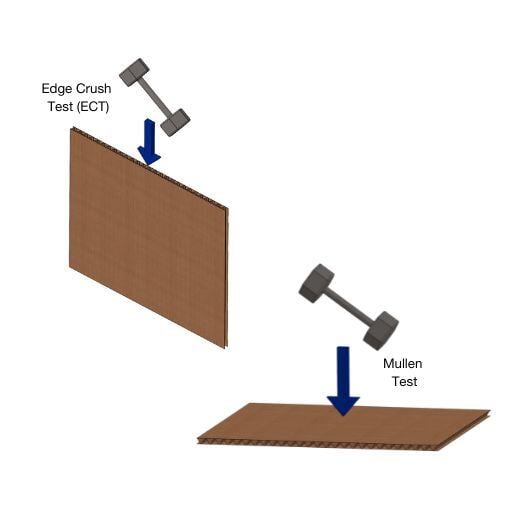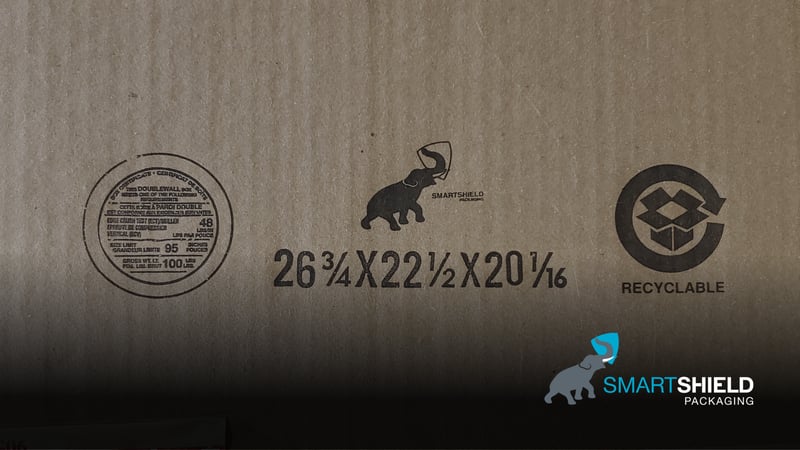Choosing the right box for your product packaging or shipping is essential to handle and satisfy customers efficiently.
A sturdy cardboard box's two most important qualities are the results of the Edge Crush Test (ECT) and the Burst Strength Test (Mullen). These measurements allow you to gauge a box's strength and durability.
Specifically, they provide a standard baseline that reveals how much weight can be stacked on top of each box when building pallets and whether the box will burst depending on both the contents or rough handling.
This article will explain the difference between ECT and Mullen tests, exploring their origins, what they measure, and their relevance in today's packaging industry.
| Aspect |
ECT (Edge Crush Test) |
Mullen Test |
| Test Focus |
Vertical strength |
Burst strength |
| Origin |
1990s |
Late 1880s |
| Primary Use |
Stacking strength for pallets |
Durability under stress |
| Testing Method |
Applying pressure downward along a vertical edge |
Hydraulic pressure to test puncture resistance |
| Material Impact |
Lower ECT with more recycled content |
Higher burst rating with virgin materials |
| Suitability for Recycled Materials |
More suitable |
Less suitable |
| Ideal for |
Products with lower burst risk |
Large, irregular, or sharp items |
| Sustainability Considerations |
Better with recycled materials |
Less efficient with recycled materials |
Introduction to Packaging Strength Tests
When judging packaging for your products, the results of both ECT and Mullen testing are worth considering.
ECT measures the vertical strength of corrugated cardboard, applying pressure downward along a vertical edge.
Mullen testing determines how much weight it takes to puncture the board.
While ECT is more widely used, Mullen was developed first in the 1880s.

The Origins and Importance of ECT and Mullen
The Mullen Burst Test became the first standard of box durability, ensuring that corrugated boxes would remain unbroken in shipping. Boxes were tested with applied weight in pounds per square inch.
However, in the 90s, corrugators introduced more recycled material in box manufacturing.
This changed the consistency of boxes and resulted in lower Mullen Burst Test ratings, but the vertical strength of boxes was still critical. To test this change, the Edge Crush Test was introduced.
Understanding the Mullen Test
The Mullen test measures whether a box will arrive intact after disordered shipping and rough handling.
Origins and Development in the Late 1880s
The Mullen Test was first introduced in 1909 when boxes were shipped individually and often by rail. In order to reduce the number of packages destroyed in transport, the Mullen Test was introduced to test cardboard before a retailer or vendor selected it.
The Mechanism of Burst Strain Test
The original method of the Mullen Test is a signature of the times: a hydraulic pressure test that applied pressure to the side of corrugated cardboard until it caved in or burst. This is where the Burst Test got its name.
Relevance of Burst Strain for Small Deliveries
The burst strain test made it possible to ship small deliveries while protecting the contents when jumbled in a train car or delivery bag. However, passing the Mullen test resulted in thicker and heavier boxes which cost more to construct and to ship.
Exploring the ECT (Edge Crush Test)
The Mullen Test remained the standard way to measure cardboard strength right up until 1991 when evolving shipping needs and new manufacturing methods introduced the Edge Crush Test to measure stacking strength in addition to puncture resistance.
Deciphering the Concept of Stacking Strength
As freight became more organized in pallets of goods compared to the irregular methods of the past, the importance of stacking became evident.
A box can resist puncture (tensile strength) but still crumple in the stack. Edge crush became a growing problem in freight. The taller the stack, the more important that the lowest boxes possess a stacking strength rating.
What does a 32 ECT Rating mean?
In order to transport 65 lbs of content, a box must have a 200 lb Mullen rating but only a 32 ECT.
The Correlation Between ECT and Packaging Durability
When ECT testing was introduced, it was found that with regular packaging, ECT provided durability and reliable shipping performance at a better price (and with more recycled materials) compared to cardboard, with a similar Mullen result.
Even though ECT does not measure the burst strength of a box, it does measure the edge crush — depending on your application — this is often sufficient.
Get help protecting your products with a free consult from a custom packaging specialist.
Distinguishing Between A, B, C, D, E, F Flutes
The ratings for corrugated flutes are measured in alphabetical rank where A is the thickest and E is the thinnest, though the rating is not exactly linear.
- A - 5mm - 36 flutes per linear foot
- B - 3mm - 49 flutes per linear foot
- C - 4mm - 41 flutes per linear foot
- D - 2.3 mm - 72 flutes per linear foot
- E - 1.5 mm - 90 flutes per linear foot
- F - 2mm - 128 flutes per linear foot
The Role of Flute Types in Determining Box Strength
Flutes are used to determine box strength. They vary in thickness and subtle construction details, such as the width between spaces and the total structural integrity.
Flutes determine both the ECT and the burst strength of boxes and are used as a standard for determining which types of products should be packaged in boxes made with corrugated cardboard of each flute rating.
Materials and Sustainability in Packaging
Using recycled materials in box manufacture is also an important aspect in shipping selection.
As we mentioned earlier, adding recycled paper to the production of corrugated cardboard reduced the Mullen burst rating but provided greater ECT for lighter boxes.
The Impact of Using Virgin Raw Materials vs Recyclable Pulp
In testing, it is found that cardboard made with higher percentages of recycled pulp are more subject to tearing but are reasonably resistant to the edge crush test when stacked.
In contrast, virgin raw materials - paper pulp made from newly cut trees - are more resistant to burst damage but with no special ECT qualities.
Sustainability Considerations in Material Selection
ECT becomes the primary rating when shipping things without a high burst risk, such as well-packaged pallets, making recycled materials a more viable option. This development is valuable because recycled paper and cardboard make up a large sector of the planet's efforts to recycle materials and cut down fewer trees.
Manufacturers that use a higher percentage of recycled pulp when producing corrugated cardboard offer a lower carbon footprint and a greener business rating for all brands that use their boxes.
Making Informed Packaging Decisions
How should you select the cardboard for your product packaging or order shipping? Knowing the difference and significance of both the ECT and Mullen testing can provide insights into how each box will hold up, considering your products and the way they are shipped.
How to Choose Between ECT and Mullen for Your Packaging Needs
For most freight, ECT is the primary rating system to determine whether your products will stack, ship, and stock well with vendors.
Large-scale order shipping also relies on a quality ECT rating to survive shipping in the stacks.
The Mullen rating, however, is crucial for assessing the durability of boxes, especially under the stress of shipping and handling.
This rating is particularly important for ensuring that boxes can withstand the pressure and potential punctures from large, irregular, or sharp items, such as workout equipment pieces, without bursting during transit.
Balancing Strength and Sustainability
Whether or not to use recycled cardboard depends on the type of product, the type of shipping, and your commitment to sustainability. Recycled cardboard with a high ECT rating might be the perfect choice for most types of packaging.
If puncture risk is high, however, choosing a thicker virgin cardboard with a higher Mullen burst rating may be better.
Which Test, ECT or Mullen, Should You Consider?
Making the right choice between ECT and Mullen for your packaging needs can ensure that products are shipped safely and effectively.
By understanding the nuances and origins of both tests, you can make informed decisions that focus on your product's safety.
Remember, a higher ECT will keep your boxes from collapsing when stacked, while a higher Mullen rating will ensure boxes arrive intact and puncture-free.
Need help deciding which packaging is best for your products? Contact our team of custom packaging specialists to protect your products today.

